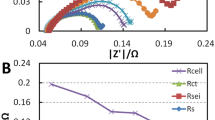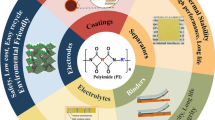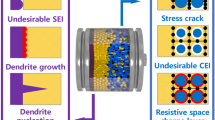Abstract
We report a breakthrough in the field of electrolyte additives for use in lithium ion batteries. Batteries containing maleimide (0.1 wt%) as an electrolyte additive absorbed moisture (H2O) from a high-humidity atmosphere. When compared with batteries without the maleimide and absorbed moisture, the capacity of batteries with the “binary additive” showed improvements of 7.4% and 5.2% in a 0.1C/0.1C cycle test, and 394% and 174% in high-power 3C rate tests conducted at room temperature and 55 °C, respectively. Thus, this innovative additive formation can effectively reduce the requirement for anhydrous conditions during the fabrication and operation of lithium ion batteries.



Similar content being viewed by others
References
S.S. Zhang: A review on electrolyte additives for lithium-ion batteries. J. Power Sources 162, 1379 (2006).
P. Verma, P. Maire, and P. Novak: A review of the features and analyses of the solid electrolyte interphase in Li-ion batteries. Electrochim. Acta 55, 6332 (2010).
H. Yamane, T. Inoue, M. Fujita, and M. Sano: A causal study of the capacity fading of Li1.01Mn1.99O4 cathode at 80 °C, and the suppressing substances of its fading. J. Power Sources 99, 60 (2001).
F.M. Wang, H.M. Cheng, H.C. Wu, S.Y. Chu, C.S. Cheng, and C.R. Yang: Novel SEI formation of maleimide-based additives and its improvement of capability and cyclicability in lithium ion batteries. Electrochim. Acta 54, 3344 (2009).
F.M. Wang, S.C. Lo, C.S. Cheng, J.H. Chen, B.J. Hwang, and H.C. Wu: Self-polymerized membrane derivative of branched additive for internal short protection of high safety lithium ion battery. J. Membrane Sci. 368, 165 (2011).
J.T. Lee, F.M. Wang, C.S. Cheng, C.C. Li, and C.H. Lin: Low-temperature atomic layer deposited Al2O3 thin film on layer structure cathode for enhanced cycleability in lithium-ion batteries. Electrochim. Acta 55, 4002 (2010).
H.H. Chang, H.C. Wu, and N.L. Wu: Enhanced high-temperature cycle performance of LiFePO4/carbon batteries by an ion-sieving metal coating on negative electrode. Electrochem. Comm. 10, 1823 (2008).
F.M. Wang, M.H. Yu, Y.J. Hsiao, Y. Tsai, B.J. Hwang, Y.Y. Wang, and C.C. Wan: Aging effects to solid electrolyte interface (SEI) membrane formation and the performance analysis of lithium ion batteries. Int. J. Electrochem. Sci. 6, 1014 (2011).
F.M. Wang, H.Y. Wang, M.H. Yu, Y.J. Hsiao, Y. Tsai: Improving the performance of high-power lithium ion batteries: differential pulse effects of solid electrolyte interface formation. J. Power Sources 196, 10395 (2011).
M.Q. Li, M.Z. Qu, X.Y. He, and Z.L. Yu: Effects of electrolytes on the electrochemical performance of Si/graphite/disordered carbon composite anode for lithium-ion batteries. Electrochim. Acta 54, 4506 (2009).
F.M. Wang, D.T. Shieh, J.H. Cheng, and C.R. Yang: An investigation of the salt dissociation effects on solid electrolyte interface (SEI) formation using linear carbonate-based electrolytes in lithium ion batteries. Solid State Ionics 180, 1660 (2010).
Acknowledgment
The authors are grateful for financial support from the National Science Council of Taiwan, R.O.C, under grants NSC 100-2628-E-011-018-MY2 and NSC 100-3113-E-011-002.
Author information
Authors and Affiliations
Corresponding author
Rights and permissions
About this article
Cite this article
Wang, FM., Cheng, CS. & Rick, J. Breakthrough additive technology for improving the performance of high-power lithium ion batteries. MRS Communications 2, 5–7 (2012). https://doi.org/10.1557/mrc.2011.21
Received:
Accepted:
Published:
Issue Date:
DOI: https://doi.org/10.1557/mrc.2011.21




